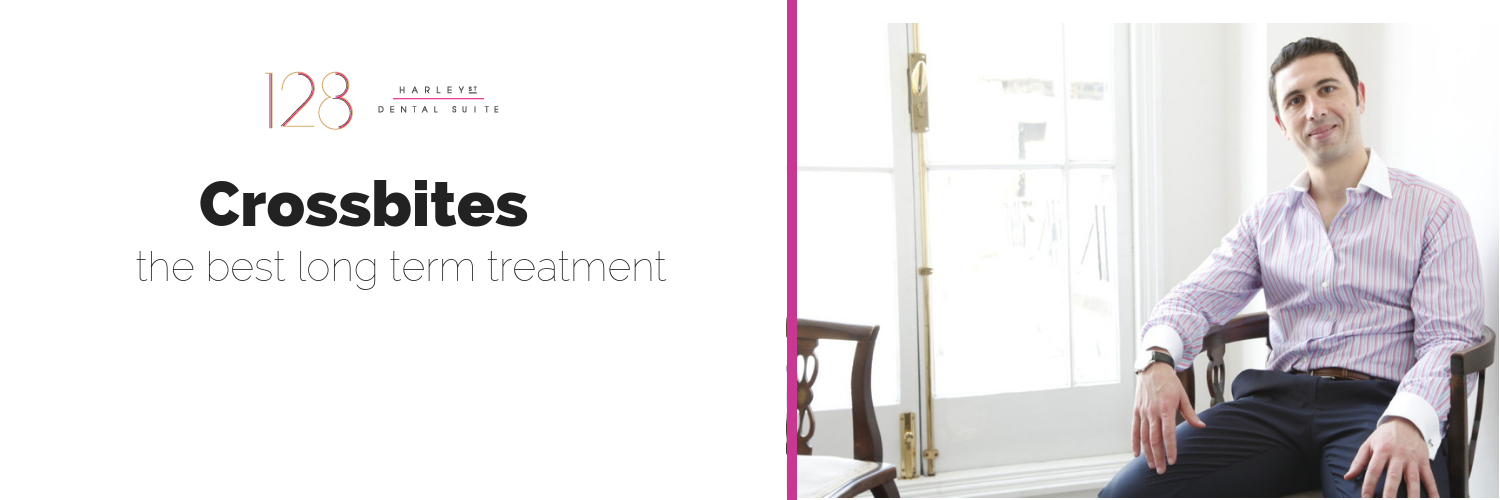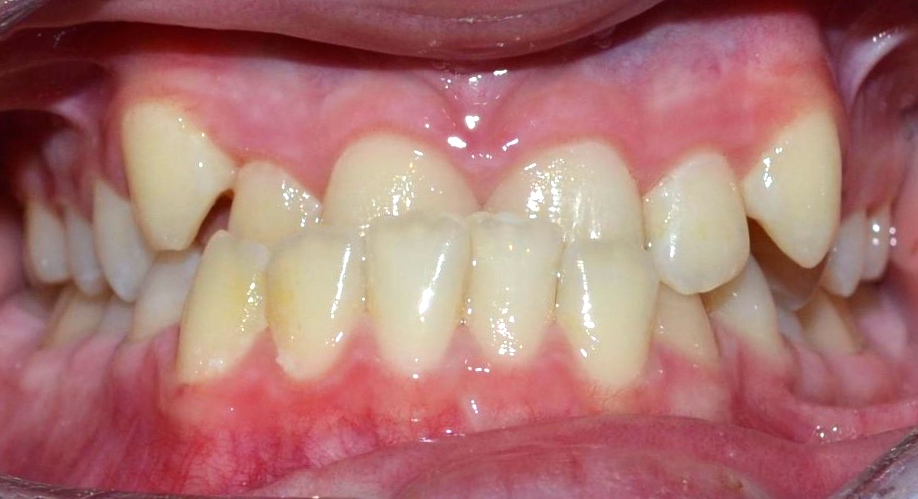 In a study in 2014 Bell and Kiebach observed that between 5% and 8% of children in the age group 3 to 12 years old had a crossbite. A further study conducted by Gungor et al in 2016 noticed up to 53.6% prevalence of crossbite in permanent dentition!
In a study in 2014 Bell and Kiebach observed that between 5% and 8% of children in the age group 3 to 12 years old had a crossbite. A further study conducted by Gungor et al in 2016 noticed up to 53.6% prevalence of crossbite in permanent dentition!
a normal dentition the top teeth in both the posterior and anterior regions will align on the outside of the lower teeth. In a crossbite situation the lower teeth will set on the outside (cheek side) of the top teeth.

The following video shows what the teeth look like with a posterior crossbite.
Crossbites can have dental or skeletal causes. If the cause is dental then it will just be the teeth which are in the wrong position, if the cause is skeletal this means that either the upper jaw is underdeveloped (superior retrusion) or the lower jaw is overdeveloped (Inferior protrusion), in short this means that either the upper jaw is too small or the lower jaw is too big.
Why should a crossbite be corrected?
Your jaw is an incredibly complex mechanism which effectively works as a ball and socket joint hinge, it is cleverly designed to hinge equally from both sides allowing us to chew in a circular motion rather than just up and down (like a crocodile!).

Because we have a joint on either side of our head this means we can hinge from either side and that circular movement can have central pivot point on either side of our head, depending on which way we are chewing. All of this means that the alignment of the teeth is incredibly important to maintain the integrity of not only the jaw joint itself but all of the supporting muscles.
If the teeth interfere with the movement of the jaw joint then this can result in headaches and pain. This pain can migrate down the head, face and neck as all of the muscles are interconnected.
A crossbite will more than likely mean that the teeth interfere with this smooth circular movement that the jaw would naturally like to undertake as it pivots around the jaw joint. Therefore correcting a crossbite will not only allow you to chew and eat more effectively but reduce the likelihood of headaches and additional muscle pain.
How can crossbites be corrected?
The key to correcting a crossbite is understanding the cause, is it dental or skeletal? Depending on the cause will likely effect the way your treatment is carried out. Simple dental crossbites may be able to be treated by your regular dentist using a treatment such as Invisalign however more serious crossbites or skeletal crossbites will more than likely need the skills of a specialist orthodontist and more advanced orthodontic braces.
Using palatal expansion to correct a crossbite
If your upper jaw is underdeveloped meaning that the teeth on the top are on the inside (tongue side) of your lower teeth then having the upper arch expanded will push the bone and top teeth further out therefore realigning all of your back teeth.
The simplest form of palatal expansion is an orthodontic appliance with a little screw on the inside. Each day the patient turns the screw a small amount (determined by the orthodontist), this puts the teeth and arch under constant pressure and gently pushes the bone and teeth further out.

The treatment is most commonly used in children during their developmental years as this then works in conjunction with their normal development and growth. Arch expansion can also be used in adults however it is often more uncomfortable and can take longer.
Once the expansion has been undertaken to correct the skeletal underdevelopment then further orthodontic treatments can be undertaken to move the teeth into the correct dental alignment.
Using a Quad Helix for correcting a crossbite
This type of orthodontic device has the same outcome as a regular palatal expander however it is fixed and cannot be removed by the patient. A couple of bands are attached to the molar teeth and then up to 4 active helix springs are used to widen the arch and therefore make room for crowded teeth or expand the arch to correct the crossbite.
Common questions and answers about correcting a crossbite
Can my orthodontist fix my crossbite underbite with braces?
Yes, a crossbite under bite can be corrected with orthodontic braces, more competent dentist with a special interest in orthodontics may be able to do this using Invisalign however more complex treatments are only available from specialist orthodontist.
How long will it take for braces to straighten my teeth?
It depends on exactly what type of treatment you require. Very often with a crossbite an arch expansion device is required to move the bone first.
A Quad Helix device will usually be worn for 3 to 6 months, after this time orthodontics may be used to correct the alignment of the teeth, this can take an additional 3 to 6 months depending on the orthodontic treatment used.
Is perfect teeth absolutely possible with braces?
This all depends upon your definition of perfection, however usually the answer is yes. This is another reason that a specialist orthodontist is one of the best people to visit for your orthodontic treatment. They will be able to give you a detailed analysis of the final result and let you know of any compromise before you begin treatment.
This is often achieved with detailed study models as well as digital imaging to give you an idea of the final result.
Do I need braces if I have a palate expander?
Usually you will require some form of braces after you have had a palatal expander. This is because the expander simply moves the bone and teeth to a further out position, more accurate orthodontic treatments are then required to move the teeth into the exact position required so that your the teeth meet together in the required manner.
What is the best age to get a palatal expander?
Treatment should ideally begin whilst your child is still growing, around the age of 10 is ideal. This then allows us to expand the arch during the growing process, it is much easier in children to expand and arch then it is with adults.
Dr. Stefan Abela
BChD, MFDS, RCS Eng, MSc, MORTH RCS Ed, AHEA, FDS Orth RCS Ed
Stefan is a Consultant in Orthodontics at one of the most prestigious London teaching hospitals; Guy’s and St Thomas NHS Foundation Trust.
Stefan is also a specialist in Orthodontics and is registered on the General Dental Council (GDC) specialist list. Stefan qualified as a dental surgeon in 2003 and underwent further training in various specialties including restorative dentistry, paediatric dentistry, oral medicine and complex oral and maxillofacial surgery including the management of facial trauma.
